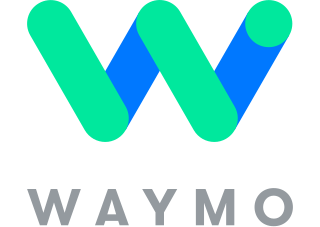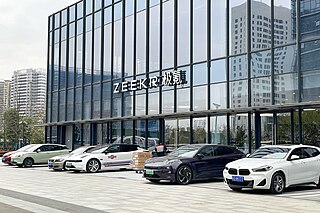
A self-driving car, also known as an autonomous car (AC), driverless car, robotaxi, robotic car or robo-car, is a car that is capable of operating with reduced or no human input. Self-driving cars are responsible for all driving activities, such as perceiving the environment, monitoring important systems, and controlling the vehicle, which includes navigating from origin to destination.

In road-transport terminology, a lane departure warning system (LDWS) is a mechanism designed to warn the driver when the vehicle begins to move out of its lane on freeways and arterial roads. These systems are designed to minimize accidents by addressing the main causes of collisions: driver error, distractions and drowsiness. In 2009 the U.S. National Highway Traffic Safety Administration (NHTSA) began studying whether to mandate lane departure warning systems and frontal collision warning systems on automobiles.

Vehicular automation involves the use of mechatronics, artificial intelligence, and multi-agent systems to assist the operator of a vehicle such as a car, lorries, aircraft, or watercraft. A vehicle using automation for tasks such as navigation to ease but not replace human control, qualify as semi-autonomous, whereas a fully self-operated vehicle is termed autonomous.

Automatic parking is an autonomous car-maneuvering system that moves a vehicle from a traffic lane into a parking spot to perform parallel, perpendicular, or angle parking. The automatic parking system aims to enhance the comfort and safety of driving in constrained environments where much attention and experience is required to steer the car. The parking maneuver is achieved by means of coordinated control of the steering angle and speed which takes into account the actual situation in the environment to ensure collision-free motion within the available space.

Waymo LLC, formerly known as the Google Self-Driving Car Project, is an American autonomous driving technology company headquartered in Mountain View, California. It is a subsidiary of Alphabet Inc, the parent company of Google.

Amnon Shashua is an Israeli computer scientist and businessman. He is the Sachs Professor of Computer Science at the Hebrew University of Jerusalem, president and chief executive officer (CEO) of the autonomous driving and driver-assistance technology company Mobileye, Co-founder of the artificial vision devices company OrCam, Founder and owner of ONE ZERO digital bank, and chairman of artificial intelligence company AI21 Labs.

Experiments have been conducted on self-driving cars since 1939; promising trials took place in the 1950s and work has proceeded since then. The first self-sufficient and truly autonomous cars appeared in the 1980s, with Carnegie Mellon University's Navlab and ALV projects in 1984 and Mercedes-Benz and Bundeswehr University Munich's Eureka Prometheus Project in 1987. Since then, numerous major companies and research organizations have developed working autonomous vehicles including Mercedes-Benz, General Motors, Continental Automotive Systems, Autoliv Inc., Bosch, Nissan, Toyota, Audi, Volvo, Vislab from University of Parma, Oxford University and Google. In July 2013, Vislab demonstrated BRAiVE, a vehicle that moved autonomously on a mixed traffic route open to public traffic.
A robotaxi, also known as robo-taxi, self-driving taxi or driverless taxi, is an autonomous car operated for a ridesharing company.
Nvidia Drive is a computer platform by Nvidia, aimed at providing autonomous car and driver assistance functionality powered by deep learning. The platform was introduced at the Consumer Electronics Show (CES) in Las Vegas in January 2015. An enhanced version, the Drive PX 2 was introduced at CES a year later, in January 2016.

Tesla Autopilot is an advanced driver-assistance system (ADAS) developed by Tesla that amounts to partial vehicle automation. Tesla provides "Base Autopilot" on all vehicles, which includes lane centering and traffic-aware cruise control. Owners may purchase an upgrade to "Enhanced Autopilot" (EA) which adds semi-autonomous navigation on limited access roadways, self-parking, and the ability to summon the car from a garage or parking spot. The company claims the features reduce accidents caused by driver negligence and fatigue from long-term driving. Collisions and deaths involving Tesla cars with Autopilot engaged have drawn the attention of the press and government agencies.
Cruise LLC is an American self-driving car company headquartered in San Francisco, California. Founded in 2013 by Kyle Vogt and Dan Kan, Cruise tests and develops autonomous car technology. The company is a largely autonomous subsidiary of General Motors. Following a series of incidents, it suspended operations in October 2023, and the CEO resigned in November 2023.

In road-transport terminology, lane centering, also known as auto steer or autosteer, is an advanced driver-assistance system that keeps a road vehicle centered in the lane, relieving the driver of the task of steering. Lane centering is similar to lane departure warning and lane keeping assist, but rather than warn the driver, or bouncing the car away from the lane edge, it keeps the car centered in the lane. Together with adaptive cruise control (ACC), this feature may allow unassisted driving for some length of time. It is also part of automated lane keeping systems.

Buffalo Automation is an artificial intelligence (AI) startup that develops autonomous navigation technology for commercial ships, recreational boats, and water taxis with the goal to improve maritime safety. It is a private company based in Buffalo, New York. Thiru Vikram is the CEO of the company.
Luminar Technologies Inc. is an American technology company that develops vision-based lidar and machine perception technologies, primarily for self-driving cars. The company's headquarters and main research and development facilities are in Orlando, Florida; a second major office is located in Palo Alto, California.

Zoox, Inc. is a subsidiary of Amazon developing autonomous vehicles that provide mobility as a service. It is headquartered in Foster City, California and has offices of operations in the San Francisco Bay Area and Seattle, Washington. Zoox sits in the Amazon Devices & Services organization alongside other Amazon units like Amazon Lab126, Amazon Alexa, and Kuiper Systems.

openpilot is an open-source, semi-automated driving system by comma.ai, Inc. When paired with comma hardware, it replaces advanced driver-assistance systems in various cars, improving over the original system. As of 2023, openpilot supports 250+ car models and has 6000+ users, having covered over 90 million miles (140,000,000 km).

Yandex self-driving car is an autonomous car project of the Russian-based technology company Yandex. The first driverless prototype launched in May 2017. As of 2018, functional service was launched in Russia with prototypes also being tested in Israel and the United States. In 2019, Yandex revealed autonomous delivery robots based on the same technology stack as the company's self-driving cars. Since 2020, autonomous robots have been delivering food, groceries and parcels in Russia and the United States. In 2020, the self-driving project was spun-off into a standalone company under the name of Yandex Self-Driving Group.
Aurora Innovation, Inc., doing business as Aurora, is a self-driving vehicle technology company based in Pittsburgh, Pennsylvania. Aurora has developed the Aurora Driver, a computer system that can be integrated into cars for autonomous driving. Aurora was co-founded by Chris Urmson, the former chief technology officer of Google/Alphabet Inc.'s self-driving team, which became known as Waymo, as well as by Sterling Anderson, former head of Tesla Autopilot, and Drew Bagnell, former head of Uber's autonomy and perception team.

Zhejiang Zeekr Intelligent Technology Co., Ltd., trading as Zeekr is a Chinese premium electric automobile brand owned by Geely Automobile Holdings. Founded in 2021, it specializes in electric cars. Zeekr's products are built on the EV-focused Sustainable Experience Architecture (SEA) platform.

Ziv Aviram is an Israeli businessman, investor, manager of several global companies, and Philanthropist, Founder and President of Aviram Foundation, co-founder, co-chairman of OrCam Technologies, and co-founder of Mobileye.















